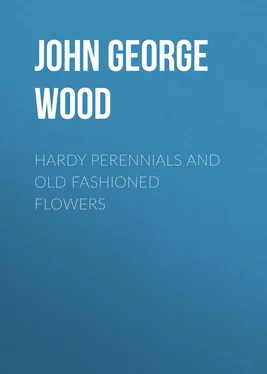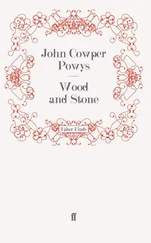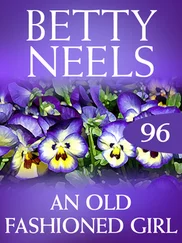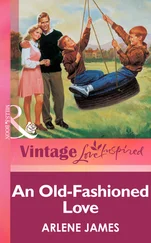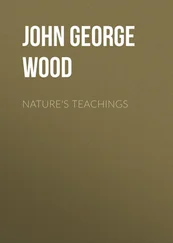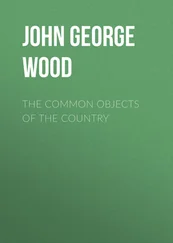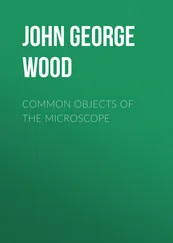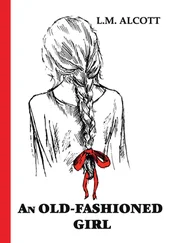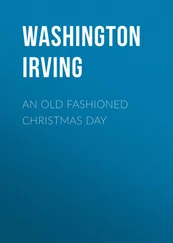John George Wood - Hardy Perennials and Old Fashioned Flowers
Здесь есть возможность читать онлайн «John George Wood - Hardy Perennials and Old Fashioned Flowers» — ознакомительный отрывок электронной книги совершенно бесплатно, а после прочтения отрывка купить полную версию. В некоторых случаях можно слушать аудио, скачать через торрент в формате fb2 и присутствует краткое содержание. Жанр: foreign_antique, Биология, Биология, foreign_edu, на английском языке. Описание произведения, (предисловие) а так же отзывы посетителей доступны на портале библиотеки ЛибКат.
- Название:Hardy Perennials and Old Fashioned Flowers
- Автор:
- Жанр:
- Год:неизвестен
- ISBN:нет данных
- Рейтинг книги:5 / 5. Голосов: 1
-
Избранное:Добавить в избранное
- Отзывы:
-
Ваша оценка:
- 100
- 1
- 2
- 3
- 4
- 5
Hardy Perennials and Old Fashioned Flowers: краткое содержание, описание и аннотация
Предлагаем к чтению аннотацию, описание, краткое содержание или предисловие (зависит от того, что написал сам автор книги «Hardy Perennials and Old Fashioned Flowers»). Если вы не нашли необходимую информацию о книге — напишите в комментариях, мы постараемся отыскать её.
Hardy Perennials and Old Fashioned Flowers — читать онлайн ознакомительный отрывок
Ниже представлен текст книги, разбитый по страницам. Система сохранения места последней прочитанной страницы, позволяет с удобством читать онлайн бесплатно книгу «Hardy Perennials and Old Fashioned Flowers», без необходимости каждый раз заново искать на чём Вы остановились. Поставьте закладку, и сможете в любой момент перейти на страницу, на которой закончили чтение.
Интервал:
Закладка:
J. G. Wood
Hardy Perennials and Old Fashioned Flowers / Describing the Most Desirable Plants, for Borders, Rockeries, and Shrubberies
A CORNER OF THE AUTHOR'S GARDEN AT KIRKSTALL.
Preface
At the present time there is a growing desire to patronise perennial plants, more especially the many and beautiful varieties known as "old-fashioned flowers." Not only do they deserve to be cultivated on their individual merits, but for other very important reasons; they afford great variety of form, foliage, and flower, and compared with annual and tender plants, they are found to give much less trouble. If a right selection is made and properly planted, the plants may be relied upon to appear with perennial vigour and produce flowers more or less throughout the year. I would not say bouquets may be gathered in the depth of winter, but what will be equally cheering may be had in blow, such as the Bluet, Violet, Primrose, Christmas Rose, Crocus, Hepatica, Squills, Snowdrops, and other less known winter bloomers. It does not seem to be generally understood that warm nooks and corners, under trees or walls, serve to produce in winter flowers which usually appear in spring when otherwise placed.
There are many subjects which, from fine habit and foliage, even when flowerless, claim notice, and they, too, are described.
Many gardens are very small, but these, if properly managed, have their advantages. The smaller the garden the more choice should be the collection, and the more highly should it be cultivated. I shall be glad if anything I say tends in this direction. From my notes of plants useful memoranda may be made, with the object of adding a few of the freest bloomers in each month, thus avoiding the error often committed of growing such subjects as mostly flower at one time, after which the garden has a forlorn appearance. The plants should not be blamed for this; the selection is at fault. No amount of time and care can make a garden what it should be if untidy and weedy plants prevail. On the other hand, the most beautiful species, both as regards foliage and flowers, can be just as easily cultivated.
The object of this small work is to furnish the names and descriptions of really useful and reliable Hardy and Perennial Plants, suitable for all kinds of flower gardens, together with definite cultural hints on each plant.
Perhaps flowers were never cultivated of more diversified kinds than at the present time; and it is a legitimate and not uncommon question to ask, "What do you grow?" Not only have we now the lovers of the distinct and showy, but numerous admirers of such species as need to be closely examined, that their beautiful and interesting features may gladden and stir the mind. The latter class of plants, without doubt, is capable of giving most pleasure; and to meet the growing taste for these, books on flowers must necessarily treat upon the species or varieties in a more detailed manner, in order to get at their peculiarities and requirements. The more we learn about our flowers the more we enjoy them; to simply see bright colours and pretty forms is far from all the pleasure we may reap in our gardens.
If I have not been able to give scientific information, possibly that of a practical kind may be of some use, as for many years, and never more than now, I have enjoyed the cultivation of flowers with my own hands. To be able to grow a plant well is of the highest importance, and the first step towards a full enjoyment of it.
I have had more especially in view the wants of the less experienced Amateur; and as all descriptions and modes of culture are given from specimens successfully grown in my own garden, I hope I may have at least a claim to being practical.
I have largely to thank several correspondents of many years' standing for hints and information incorporated in these pages.
J. WOOD. Woodville, Kirkstall, November, 1883.Acæna Novæ Zealandiæ
The plant, as may be seen by the illustration (Fig. 1), is small, and its flowers are microscopic, hardly having the appearance of flowers, even when minutely examined, but when the bloom has faded there is a rapid growth, the calyces forming a stout set of long spines; these, springing from the globular head in considerable numbers, soon become pleasingly conspicuous, and this is by far the more ornamental stage of the plant. It is hardy, evergreen, and creeping. It seldom rises more than one or two inches from the ground, and only when it approaches a wall, stones, or some such fixed body, does it show an inclination to climb; it is, therefore, a capital rock plant. As implied by its specific name, it comes from New Zealand, and has not long been acclimatised in this country.
The flowers are produced on fine wiry stems an inch or more long, being nearly erect; they are arranged in round heads, at first about the size of a small pea; these, when bruised, have an ammoniacal smell. Each minute flower has four green petals and brownish seed organs, which cause the knob of flowers to have a rather grimy look, and a calyx which is very hard and stout, having two scales and four sepals. These sepals are the parts which, after the seed organs have performed their functions, become elongated and of a fine rosy-crimson colour; they form stiff and rather stout spines, often ¾in. long; they bristle evenly from every part of the little globe of seed vessels, and are very pretty. The spines are produced in great abundance, and they may be cut freely; their effect is unique when used for table decoration, stuck in tufts of dark green selaginella. On the plant they keep in good form for two months. The leaves are 1in. to 2in. long, pinnate; the leaflets are of a dark bronzy colour on the upper side and a pale green underneath, like maidenhair, which they also resemble in form, being nearly round and toothed. They are in pairs, with a terminal odd one; they are largest at the extremity, and gradually lessen to rudimentary leaflets; the foliage is but sparingly produced on the creeping stems, which root as they creep on the surface.
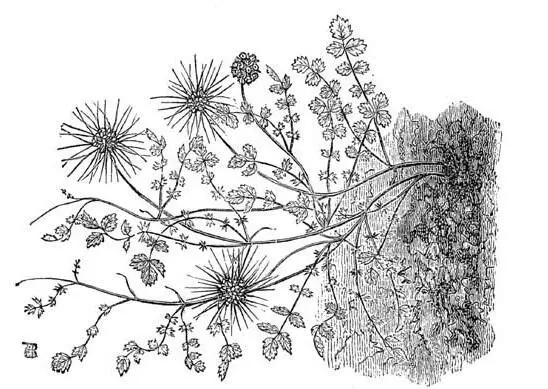
Fig. 1. Acæna Novæ Zealandiæ.
(One half natural size.)
The habit of the plant is compact and cushion-like, and the brilliant spiny balls are well set off on the bed of fern-like but sombre foliage. During August it is one of the most effective plants in the rock garden, where I find it to do well in either moist or dry situations; it grows fast, and, being evergreen, it is one of the more useful creepers for all-the-year-round effect; for covering dormant bulbs or bare places it is at once efficient and beautiful. It requires light soil, and seems to enjoy grit; nowhere does it appear in better health or more at home than when carpeting the walk or track of the rock garden.
It is self-propagating, but when it is desirable to move a tuft of it, it should be done during the growing season, so that it may begin to root at once and get established, otherwise the wind and frosts will displace it.
It blooms from June to September, more or less, but only the earliest flowers produce well-coloured spines.
Achillea Ægyptica
This is an evergreen (though herb-like) species. It has been grown for more than 200 years in English gardens, and originally came, as its name implies, from Egypt. Notwithstanding the much warmer climate of its native country, it proves to be one of the hardiest plants in our gardens. I dare say many will think the Yarrows are not worthy of a place in the garden; but it should not be forgotten that not only are fine and useful flowers included in this work, but also the good "old-fashioned" kinds, and that a few such are to be found amongst the Yarrows is without doubt. Could the reader see the collection now before me, cut with a good piece of stem and some foliage, and pushed into a deep vase, he would not only own that they were a pleasing contrast, but quaintly grand for indoor decoration.
Читать дальшеИнтервал:
Закладка:
Похожие книги на «Hardy Perennials and Old Fashioned Flowers»
Представляем Вашему вниманию похожие книги на «Hardy Perennials and Old Fashioned Flowers» списком для выбора. Мы отобрали схожую по названию и смыслу литературу в надежде предоставить читателям больше вариантов отыскать новые, интересные, ещё непрочитанные произведения.
Обсуждение, отзывы о книге «Hardy Perennials and Old Fashioned Flowers» и просто собственные мнения читателей. Оставьте ваши комментарии, напишите, что Вы думаете о произведении, его смысле или главных героях. Укажите что конкретно понравилось, а что нет, и почему Вы так считаете.
